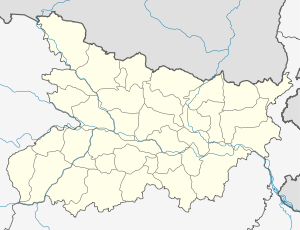Supaul
| Supaul | |
|---|---|
| Town | |
 Supaul Location in Bihar, India | |
| Coordinates: 26°07′34″N 86°36′18″E / 26.126°N 86.605°ECoordinates: 26°07′34″N 86°36′18″E / 26.126°N 86.605°E | |
| Country |
|
| State | Bihar |
| District | Supaul |
| Elevation | 34 m (112 ft) |
| Population (2011) | |
| • Total | 65,437 |
| Languages | |
| • Official | Maithili, Hindi, Urdu |
| Time zone | UTC+5:30 (IST) |
| Vehicle registration | BR-50 |
| Lok Sabha constituency | Supaul |
| Vidhan Sabha constituency | Supaul, Pipra, Supaul, Tribeniganj, Chhatapur, nirmali |
| Website | http://www.supaul.bih.nic.in/ |
Supaul is a town and a municipality that is headquarters of Supaul district in the Indian state of Bihar. The Supaul town is the administrative headquarters of this district.
History
Supaul, which was previously a part of Saharsa district, is part of the Mithila region.[1] Mithila first gained prominence after being settled by Indo-Aryan peoples who established the Mithila Kingdom (also called Kingdom of the Videhas).[2] During the late Vedic period (c. 1100–500 BCE), Videha became one of the major political and cultural centers of South Asia, along with Kuru and Pañcāla. The kings of the Videha Kingdom were called Janakas.[3] The Videha Kingdom was later incorporated into the Vajji confederacy, which had its capital in the city of Vaishali, which is also in Mithila.[4]
Geography
Supaul is located at 25°56′N 86°15′E / 25.93°N 86.25°E.[5] It has an average elevation of 34 metres (111 feet).
Demographics
As of 2011 India census,[6] Supaul had population of 2,228,397 of which male and female were 1,157,815 and 1,070,582 respectively. The initial provisional data suggest a density of 919 in 2011 compared to 714 of 2001.
Education Institutions
- Williams High School
- Govt. ITI College
- Rsm Public School,Supaul
References
- ↑ https://books.google.co.in/books?id=A0i94Z5C8HMC&lpg=PA30&pg=PA27&redir_esc=y#v=onepage&q&f=false
- ↑ Michael Witzel (1989), Tracing the Vedic dialects in Dialectes dans les litteratures Indo-Aryennes ed. Caillat, Paris, pages 13, 17 116–124, 141–143
- ↑ Witzel, M. (1989). "Tracing the Vedic dialects". In Caillat, C. Dialectes dans les litteratures Indo-Aryennes. Paris: Fondation Hugot. pp. 141–143.
- ↑ Hemchandra, R. (1972). Political History of Ancient India. Calcutta: University of Calcutta.
- ↑ Falling Rain Genomics, Inc - Supaul
- ↑ "Census of India 2001: Data from the 2001 Census, including cities, villages and towns (Provisional)". Census Commission of India. Archived from the original on 2004-06-16. Retrieved 2008-11-01.